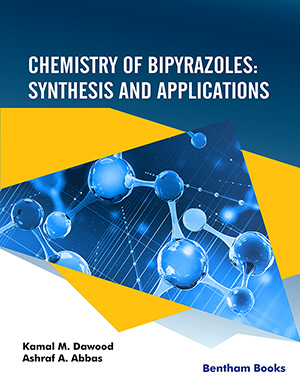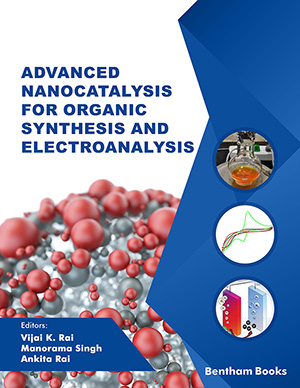
Abstract
Background: High efficiency in terms of reaction yield and purity has led to the extensive utilization of copper-catalyzed azide-alkyne cycloaddition (CuAAC) in various fields of chemistry. Its compatibility with low molecular weight alcohols promotes the application in surfactant synthesis to tackle the miscibility constraints of the reactants.
Objective: For the tuning of surfactant properties, double click coupling of the antipode precursors was attempted. Failure of the CuAAC to provide the targeted product in combination with unexpected reaction outputs led to an investigation of the side reaction. Methods: The CuAAC-based coupling of sugar azide with propargyl building block in the presence of copper- (I) catalyst exclusively led to the mono-coupling product in a respectable yield of almost 80%. Besides the unexpected incomplete conversion, the loss of the remaining propargyl group, as indicated by both NMR and MS. On the other hand, application of substantial amounts of CuSO4 under reducing conditions in refluxing toluene/water furnished the alkyne dimer in a moderate yield of 43%, while no change of azide compound was noticed. Results: The Cu(I)-catalyst applied for azide-alkyne cycloadditions enables the homo-coupling of certain terminal alkynes at a higher temperature. Moreover, aromatic propargyl ethers may be cleaved to furnish the corresponding phenol. The copper-catalyzed coupling appeared highly sensitive towards the alkyne compound. Only selected derivatives of propargyl alcohol were successfully dimerized. Conclusions: The observed failure of the Huisgen reaction for the synthesis of sugar-based surfactants may indicate non-recognized constrains of the reaction, which could affect its wide application in bioconjugation. The temperature requirement for the alternative dimerization of terminal alkynes renders this side reaction nonrelevant for typical click couplings, while narrow substrate diversity and moderate yield limit its synthetic application.Keywords: Click Chemistry, Huisgen cycloaddition, alkyne dimerization, aryl-propargyl ether cleavage, Copper azide alkyne cycloaddition (CuAAC), depropargylation.
[http://dx.doi.org/10.1002/1521-3773(20010601)40:11<2004:AID-ANIE2004>3.0.CO;2-5] [PMID: 11433435]
[http://dx.doi.org/10.1021/cr0783479] [PMID: 18698735]
[http://dx.doi.org/10.1002/9780470748862]
[http://dx.doi.org/10.1016/S1359-6446(03)02933-7] [PMID: 14678739]
[http://dx.doi.org/10.1039/B618048P] [PMID: 17377651]
(b) Ali, T.H.; Tajuddin, H.A.; Hussen, R.S.D.; Heidelberg, T. Increased emulsion stability for reverse Y‐shaped sugar‐based surfactants. J. Surfactants Deterg., 2015, 18, 881-886. http://10.1007/s11743-015-1710-x
(c) Ng, S.H.; Heidelberg, T.; Salman, A.A. Spacer effect on triazole-linked sugar-based surfactants. J. Disp. Sci. Tech., 2017, 38, 105-109.
[http://dx.doi.org/10.1080/01932691.2016.1144513]
[http://dx.doi.org/10.1016/j.carres.2013.06.020] [PMID: 23872788]
(b) Oldham, E.D.; Nunes, L.M.; Varela-Ramirez, A.; Rankin, S.E.; Knutson, B.L.; Aguilera, R.J.; Lehmler, H-J. Cytotoxic activity of triazole-containing alkyl β-D-glucopyranosides on a human T-cell leukemia cell line. Chem. Cent. J., 2015, 9, 3.
[http://dx.doi.org/10.1186/s13065-014-0072-1] [PMID: 25705252]
[http://dx.doi.org/10.1021/cr8005087] [PMID: 19331408]
(b) bAlbrecht, M. C4- bound imidazolylidenes: from curiosities to high-impact carbene ligands. Chem. Commun. (Camb.), 2008, 31(31), 3601-3610.
[http://dx.doi.org/10.1039/b806924g] [PMID: 18665276]
(c) Mathew, P.; Neels, A.; Albrecht, M. 1,2,3-Triazolylidenes as versatile abnormal carbene ligands for late transition metals. J. Am. Chem. Soc., 2008, 130(41), 13534-13535.
[http://dx.doi.org/10.1021/ja805781s] [PMID: 18785741]
(d) Lalrempuia, R.; McDaniel, N.D.; Müller-Bunz, H.; Bernhard, S.; Albrecht, M. Water oxidation catalyzed by strong carbene-type donor-ligand complexes of iridium. Angew. Chem. Int. Ed. Engl., 2010, 49(50), 9765-9768.
[http://dx.doi.org/10.1002/anie.201005260] [PMID: 21064071]
[http://dx.doi.org/10.1016/j.tetlet.2009.08.002]
[http://dx.doi.org/10.1246/cl.2010.920]
[http://dx.doi.org/10.1016/j.tetlet.2011.09.004]
[http://dx.doi.org/10.1021/jo952054a]
[http://dx.doi.org/10.1021/ma300654j]
[http://dx.doi.org/10.1016/j.colsurfb.2014.10.054] [PMID: 25465761]
(b) Wang, G.N.; André, S.; Gabius, H.J.; Murphy, P.V. Bi- to tetravalent glycoclusters: synthesis, structure-activity profiles as lectin inhibitors and impact of combining both valency and headgroup tailoring on selectivity. Org. Biomol. Chem., 2012, 10(34), 6893-6907.
[http://dx.doi.org/10.1039/c2ob25870f] [PMID: 22842468]
[http://dx.doi.org/10.1021/jo970284e]
[http://dx.doi.org/10.1039/C3CC44371J]
[http://dx.doi.org/10.1039/c0ob01089h] [PMID: 21451844]
[http://dx.doi.org/10.1002/pola.26165]
[http://dx.doi.org/10.1016/j.dyepig.2012.01.012]
[http://dx.doi.org/10.1039/b924888a] [PMID: 20198238]
[http://dx.doi.org/10.1016/0008-6215(92)80029-Z]
[http://dx.doi.org/10.1016/S0040-4020(98)00405-0]
[http://dx.doi.org/10.1002/(SICI)1099-0739(199608)10:6<421:AID-AOC495>3.0.CO;2-C]
[http://dx.doi.org/10.1039/p19860001215]
(b) Garwood, R.F.; Oskay, E.; Weedon, B.C.L. Triglyceride studies. Chem. Ind., 1962, 1684. (B) (a) A.S. Batasanov, J.C. Collings, I.J.S. Fairlamb, J.P. Holland, J.A.K. Howard, Z, Lin, T.B. Marder, A.C. Parsons, R.M. Ward, J. Zhu. Requirement for an oxidant in Pd/Cu Co-catalyzed terminal alkyne homocoupling to give symmetrical 1,4-disubstituted 1,3-diynes. J. Org, Chem., 2005, 70, 703-706; (b) I.J.S. Fairlamb, P.S. Baeuerlein, L.R. Marrison, J.M. Dickinson. Pd-catalysed cross coupling of terminal alkynes to diynes in the absence of a stoichiometric additive. Chem. Commun. 2003, 2003, 632-633. (C) Trostyanskaya, I.G.; Beletskaya, I.P. A copper (I or II)/diethylphosphite catalytic system for base-free additive dimerization of alkynes. Tetrahedron, 2017, 73, 148-153. (D) L. Xu, X.-L. Chen, Q. Zhang, L.-B. Qu, W.-Z. Bi, K. Sun, J.-Y. Chen, Z. Xin, Y.-F. Zhao. CuSO4-H-phosphonate catalyzed highly stereo- and regioselective dimerization of terminal alkynes. RSC Adv.,2015, 5, 5004-5009. (E) Masuda, Y.; Sato, K. New type formation of 1,3-enynes (or internal alkynes) via coupling of organoboranes with alkynylcopper compounds mediated by copper(II). Chem. Commun., 1998,1998, 807-808. (F) Zhao, Y.-H. Luo, Y. Wang, H. Wei, H. Guo, T. Tan, H. Yuan, L. Zhang, X.-B. A novel ratiometric and reversible fluorescence probe with a large Stokes shift for Cu2+ based on a new clamp-on unit. Anal. Chim. Acta., 2019, 1065, 134-141. (H) Rawat, D.S.; Zaleski, J.M. Syntheses and thermal reactivities of symmetrically and asymmetrically substituted acyclic enediynes: Steric control of Bergman cyclization temperatures. Chem. Commun. (Camb.), 2000, 2493-2494.
[http://dx.doi.org/10.1021/om400678d]
[http://dx.doi.org/10.1016/S0040-4039(97)01396-8]
[http://dx.doi.org/10.1021/ol027382t] [PMID: 12556189]
(b) Rambabu, D.; Bhavani, S.; Swamy, N.K.; Rao, M.V.B.; Pal, M. Pd/C-mediated depropargylation of propargyl ethers/amines in water. Tetrahedron Lett., 2013, 54, 1169-1173.
[http://dx.doi.org/10.1016/j.tetlet.2012.12.093]
[http://dx.doi.org/10.1021/om990912d]
[http://dx.doi.org/10.1016/j.jorganchem.2007.06.030]
[http://dx.doi.org/10.1021/om010178+]
[http://dx.doi.org/10.1039/b409851j] [PMID: 15568090]
[http://dx.doi.org/10.1021/om050355x]
[http://dx.doi.org/10.1039/B511148J] [PMID: 16372104]
[http://dx.doi.org/10.1039/C6CC00029K] [PMID: 26838677]
[http://dx.doi.org/10.1016/S0040-4020(02)00669-5]
[http://dx.doi.org/10.1021/jp5002918]
[http://dx.doi.org/10.1021/jo01056a511]
[http://dx.doi.org/10.1021/jo5025909] [PMID: 25514331]
[http://dx.doi.org/10.1039/B715563H] [PMID: 18188476]
[http://dx.doi.org/10.1039/b706926j] [PMID: 18219789]
 48
48 6
6


























